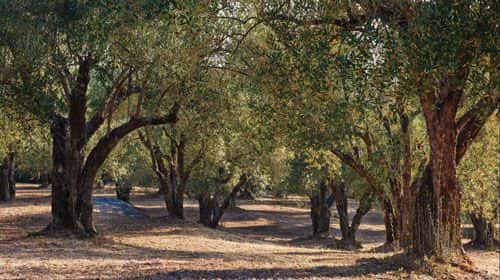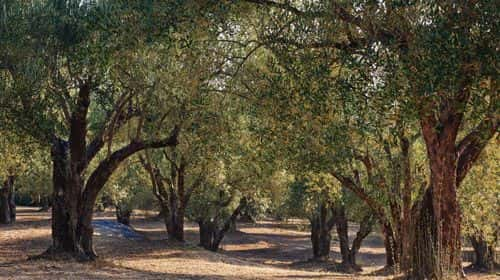
Growing olives to make premium extra virgin olive oil (EVOO) seems to be more of a calling in the North Bay than a lucrative venture. For those who pursue it, however, producing quality olive oil is its own reward.
“The Olive Press is all about quality,” says Teresa Hernando, general manager. “We mill small batches of California olives, bottle and sell direct to the consumer. Each of our extra virgin olive oils has a distinct flavor based on the varietal.” The Olive Press is located inside the Jacuzzi Family Vineyards on Arnold Drive south of Sonoma and has a second location at Oxbow Public Market in Napa. It’s owned by Fred and Nancy Cline, proprietors of Jacuzzi Family Vineyards and also Cline Family Cellars.
Using fruit from its own orchards near Petaluma and Glen Ellen, Olive Press grows approximately 45 tons of Italian varietal olives each year, resulting in about 2,000 gallons of extra virgin oil. The organic grove in Glen Ellen, privately owned, and located along Sonoma Mountain Road, totals about 10 acres. Olive Press also outsources from other growers, located in the Capay Valley and near Corning. The company makes about 15 EVOOs ranging in flavor from delicate to robust, along with several herb- and citrus-infused oils and a line of dipping oils.
Pruning and irrigation
Most olive oil producers in the North Bay grow some combination of Italian, Sicilian, and/or Spanish varietals: Leccino, Pendolino, Frantoio, Moraiolo, Maurino, Picholine, Coratina, Sevillano, Leccio del Corno, Nocellara de Belice and more.
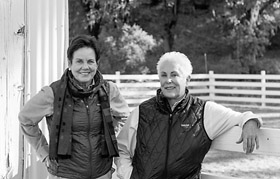 Olive trees are alternate fruit bearers, producing a bumper crop one year and not as much the next year. But serious growers have a workaround. Bonnie Storm and Nena Talcott, co-owners of Grove 45 EVOO, implemented a precise pruning program several years ago on Storm’s ranch in the hills of Chiles Valley, northeast of St. Helena.
Olive trees are alternate fruit bearers, producing a bumper crop one year and not as much the next year. But serious growers have a workaround. Bonnie Storm and Nena Talcott, co-owners of Grove 45 EVOO, implemented a precise pruning program several years ago on Storm’s ranch in the hills of Chiles Valley, northeast of St. Helena.
“Pruning is the most important task that has to be done to olive trees to maximize production and quality,” explains Talcott. “By properly pruning, we now have more consistent output from year to year.”
Irrigation is also key to higher production. “Olive trees are like weeds––difficult to kill, and they can grow without water,” she says. “But without water the yield isn’t as high. Most of the Europeans farm olives without water, but here in California we love to irrigate,” she says.
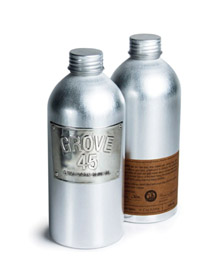 Storm and Talcott’s 500 olive trees yield approximately seven to nine tons of fruit each year, enough to make about 300 gallons of oil. They also buy a percentage of oil that goes into their Grove 45 blend from a couple of growers on the valley floor. “Those growers have the same trees and farm the same way we do, and we all take the fruit to the same milling facility where it’s blended.”
Storm and Talcott’s 500 olive trees yield approximately seven to nine tons of fruit each year, enough to make about 300 gallons of oil. They also buy a percentage of oil that goes into their Grove 45 blend from a couple of growers on the valley floor. “Those growers have the same trees and farm the same way we do, and we all take the fruit to the same milling facility where it’s blended.”
The two owners of Grove 45 (a reference to the year they were both born) deliver their freshly-harvested fruit to a certified organic mill in Kelseyville. “Our groves are certified organic, and it’s an expensive nightmare to get and keep that certification,” says Talcott. “Our oil is organic, but because of the certification restrictions we aren’t allowed to say that unless we pursue another certification. And we’re too small to go through that process.”
Like some limited-production, ultra-premium wines enjoy a cult following, so does Grove 45. “We make only 350 cases a year, and we always sell out by the next harvest, which is ideal,” says Talcott. “Our oil is sold in small specialty stores around the nation and through a few online retailers. In the past 15 years the American consumer has become more educated about good olive oil, and they know to avoid oils that have been sloshing around in a tanker truck.”
Grove 45’s unique packaging is a bottle made of opaque extuded aluminum, with an embossed pewter label crafted in France that the owners apply by hand. “If you’re going to make a quality product like ours, the cost is high,” says Talcott. “The business barely breaks even, but we have a good following.”
Race to the mill
 "Once olives have been picked, it’s a race against the clock to get them processed. “Generally, you have 24 hours from harvesting to milling. As soon as the fruit comes off the trees and arrives at the mill, we send them on through,” says Hernando of the Olive Press, which uses a Pieralisi mill crafted in Italy for the milling season, typically from October to January.
"Once olives have been picked, it’s a race against the clock to get them processed. “Generally, you have 24 hours from harvesting to milling. As soon as the fruit comes off the trees and arrives at the mill, we send them on through,” says Hernando of the Olive Press, which uses a Pieralisi mill crafted in Italy for the milling season, typically from October to January.
“We operate our mill 24/7 during the season,” she says. “Many private olive growers mill at The Olive Press. Custom milling is by appointment only, and we offer two Community Press Days. Once milled, the oil is picked up by the customer who stores and bottles it elsewhere. Our Olive Press products are milled, stored and bottled here.”
Earlier this year, the Olive Press’s Lunigiana certified organic EVOO earned an ExtraGold award for the third year in a row at the 23rd BIOL International olive oil competition in Rome. It also won two gold medals at the California State Fair olive oil competition and two gold medals at the 2018 Yolo County Fair.
One of the Olive Press’s newest products is a three-liter box of EVOO, packaged like premium wine in a box. “The oil is protected from UV light, it’s airtight, and you place your container under the spigot. We’re hoping this really takes off with consumers,” says Hernando.
From groves to vineyards
 Ridgely Evers got into olive farming three-plus decades ago, when he shipped more than 2,000 cuttings from an 800-year-old grove in Tuscany, and they thrived here. “It was just dumb luck that I did that instead of buying nursery stock,” explains Evers, owner of DaVero Farms & Winery on Healdsburg’s Westside Road. “We make a spectacular olive oil that is considered one of the best in the world.” DaVero’s EVOO was the first American oil to win a blind tasting in Italy in 1997.
Ridgely Evers got into olive farming three-plus decades ago, when he shipped more than 2,000 cuttings from an 800-year-old grove in Tuscany, and they thrived here. “It was just dumb luck that I did that instead of buying nursery stock,” explains Evers, owner of DaVero Farms & Winery on Healdsburg’s Westside Road. “We make a spectacular olive oil that is considered one of the best in the world.” DaVero’s EVOO was the first American oil to win a blind tasting in Italy in 1997.
But Evers no longer enters DaVero’s EVOO in competitions. “There is no top olive oil, but sometimes we still get entered into a competition by someone else, like a chef, without even knowing it. We’re now at a point where we are basically selling to our club members, and almost everything we produce here is already sold.”
DaVero makes a Meyer lemon olive oil as well. The lemon rinds are crushed and pressed together with the olives. “That oil is our gateway drug,” he laughs. “It is simply spectacular as a finish on warm dishes like fish and pastas, but not as versatile as our extra virgin.”
Evers is in the process of removing 250 of DaVero’s olive trees because, as he muses, “They’re in a place where I should have planted vineyards.” At press time, Evers hadn’t yet decided what winegrapes to plant, but it will be Italian varietals, most likely a red and a white. The olive trees transplant well, and have found a new home not far away on a neighbor’s estate.
An abundance of good oil
“Olive production is rarely a challenge,” says Evers. “The issue is sales––sales margins, in particular. I’m frequently asked how I got into the olive oil business, and I say ‘bad math.’ A ton of grapes yields 150 gallons of juice, but a ton of olives yields only 30 gallons of oil. There’s also a huge proliferation of brands out there, almost a glut on the market,” he adds. “So trying to establish a new brand of oil in today’s market is difficult. The math doesn’t add up for widespread distribution unless you’re a huge operation.”
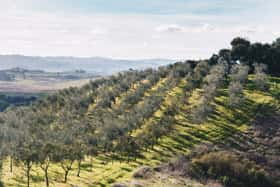 The biggest challenge for DaVero, says Evers, is labor. “Harvesting is hands down the most costly factor of growing olives, because it’s hard work and labor has become more scarce and more expensive. Machine harvesting doesn’t work here. It only works on certain olive clones and varietals that don’t produce particularly distinguished oil.”
The biggest challenge for DaVero, says Evers, is labor. “Harvesting is hands down the most costly factor of growing olives, because it’s hard work and labor has become more scarce and more expensive. Machine harvesting doesn’t work here. It only works on certain olive clones and varietals that don’t produce particularly distinguished oil.”
Olive trees, says Evers, are typically planted where more productive crops won’t grow, or along the edge of pastures and fields. “Except in really arid parts of Italy and Spain, olives are not a primary crop. It’s rare to find olives as the primary crop in an area that has an alternate primary income source, such as grapes or cattle, because the economics don’t support it.”
Nature has a way of teaching that to you over time, Evers says. “We started with olives, which was fortunate, because I thought maybe an idiot like me who can make olive oil can also grow other stuff. That’s how I backed into the wine business. But for most people, we recommend they grow enough olives for their own consumption or buy someone else’s oil, but you don’t want to plant big fields of olive trees in a region where something else grows more productively. Had we not started growing olives early in our business, then built up a strong brand and a strong following, I would not be growing olives today.”
The complexities of pests
Even when growing conditions are good and olive groves seem happy, one threat is always present: Bactrocera (Dacus) Oleae, more commonly known as the olive fruit fly. (See sidebar Beware the Olive Fruit Fly). “Since 1998, it has spread into all of California’s olive growing regions, as well as into Mexico,” says Evers. “And sooner or later, the olive moth will arrive and add a whole new level of complexity. It’s already in California, and when it gets here we’ll deal with it. Unfortunately, there are many olive trees around here that are volunteers, abandoned decades ago. So there is opportunity for the fly to thrive in those trees even when growers like us are trying to prevent it.”
The owners of Grove 45 keep the olive fly away from their trees by carefully applying an organic spray. “We use a spray that acts more like a sticky fly paper, applied to the trunk of the tree and its major branches. We apply this every two weeks during growing season, alternating rows,” says Talcott.
She admits that being in the cult-status EVOO business is a labor of love. “There’s no money in olive oil in the quantity we produce, but we do it because we love it. It’s very expensive to produce great oil, and the average person can only use so much.”
Acreage and Tonnage
 A crop report, released by the Sonoma County Department of Agriculture in 2016, reveals that the county had 381 acres of bearing olive trees that year, valued at $701,000. By comparison, the county’s 2015 Crop Report recorded 427 acres of bearing trees valued at $521,500. Olive trees generally bear a big crop one year, followed by a lighter crop the following year.
A crop report, released by the Sonoma County Department of Agriculture in 2016, reveals that the county had 381 acres of bearing olive trees that year, valued at $701,000. By comparison, the county’s 2015 Crop Report recorded 427 acres of bearing trees valued at $521,500. Olive trees generally bear a big crop one year, followed by a lighter crop the following year.
“Tonnage in olives varies from year to year,” says Tracy Cleveland, assistant agricultural commissioner for Napa County. “One factor is because olives are an alternate-year crop, and sometimes there are more climatic and/or pest challenges.”
Napa County’s 2016 Crop Report shows 142 acres of olive groves there produced 289 tons of fruit (approximately 2 tons per acre), with a value of $456,900. The 2015 Crop Report recorded 140 acres producing olives (about 280 tons), with a value of $300,300.
Beware the Olive Fruit Fly
The pest that poses the greatest threat to olives is the olive fruit fly, a small insect with clear wings, dark veins, and a small dark spot at the wing tip. It has infiltrated the North American olive industry since first being detected here in 1998. Both commercial olive growers and hobbyists with a backyard tree must remain aware to quickly identify and treat an infestation.
Early-emerging olive fruit flies infest old, unharvested fruit in the spring, and the later-emerging flies can infest newer fruit closer to summer. They can also develop in unharvested fruit during the winter and spring, and then emerge and lay eggs in new fruit by the summer. (The flies migrate to the soil in fall and winter.) Infested olives will show “stings” on the surface, resembling little brown spots or tiny dimples. This indicates destruction of the pulp. Traps and special sprays can be used if necessary to help keep the flies from becoming established.
The best way to control an infestation is to harvest all fruit each year and properly dispose of damaged fruit.
Source: theolivepress.com
Limited Production, High Quality
Though producers of exceptional EVOO in the North Bay are too numerous to mention, a few stand out for farming both vineyards and olive groves and marketing their wines and artisanal oils side-by-side.
“Many wineries sell their oils at premium prices at the winery, which is obviously far more lucrative than selling wholesale,” says Tracy Cleveland, assistant agricultural commissioner for Napa County.
In Napa County, Long Meadow Ranch’s Mayacamas Estate at Rutherford claims to have the oldest olive orchards in the county, dating to the 1870s and later abandoned during Prohibition. The Hall family, owners of the property, discovered the groves more than 20 years ago and diligently brought them back to productive use. The Halls cultivate eight acres of the old trees and have also propagated new trees to fill in missing plots in the historic grove.
 “An average yield per ton of these olives is 30 to 40 gallons,” says Chris Hall, executive vice president and chief operating officer of Long Meadow Ranch. “All of our oils are produced from estate-grown olives.” The ranch has its own Pieralisi mill, a “micro” mill specifically designed for manufacturing small-production, ultra premium olive oils. When harvest rolls around, the olives come off the ancient trees and go directly to the mill, only a two-minute tractor ride from the groves.
“An average yield per ton of these olives is 30 to 40 gallons,” says Chris Hall, executive vice president and chief operating officer of Long Meadow Ranch. “All of our oils are produced from estate-grown olives.” The ranch has its own Pieralisi mill, a “micro” mill specifically designed for manufacturing small-production, ultra premium olive oils. When harvest rolls around, the olives come off the ancient trees and go directly to the mill, only a two-minute tractor ride from the groves.
Long Meadow Ranch produces Prato Lungo organic EVOO, with olives exclusive from the old grove, the Napa Valley Select organic EVOO, and the Limonato organic oil, which is created by milling whole, fresh organic Meyer lemons and organic Bearss limes with the organic olives, all estate grown. The oils are available directly from Long Meadow Ranch at its General Store at Farmstead in St. Helena, at its new tasting room in Anderson Valley in Philo, and on its website longmeadowranch.com.
Also in Rutherford, Round Pond Estate began importing and planting olive trees 20 years ago. Spanning 12 acres, the 2,200 estate-grown trees, produce the Tuscan-variety Leccino and the Spanish Sevillano. Round Pond built its own mill, where the olives are pressed in either a stone mill or a hammer mill. It markets two EVOOs, as well as a Blood Orange Olive Oil and a Meyer Lemon Olive Oil, and several herbed and seasoned oils. Round Pond gives tours of the mill and also offers tastings.
Sonoma County’s B.R. Cohn Winery and Olive Oil Company is credited with producing the first estate olive oil in Northern California in more than a century when it was first pressed in 1990. The 468 estate-grown Picholine olive trees on the property date to the mid-1800s, and the oils produced in limited quantities have won many recent awards at the Sonoma County Harvest Fair.
McEvoy Ranch near Petaluma cemented its reputation on exceptional estate-grown EVOO. The farm-to-table process is completed entirely on the ranch—growing the olives, harvesting, milling, blending and bottling. McEvoy produces several small-batch oils and production ebbs and flows with each year’s crop. Its best-known oils are Traditional Blend and Olio Nuovo.
Author
-

Jean Doppenberg is a lifelong journalist and the author of three guidebooks to Wine Country.
View all posts


